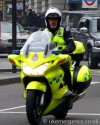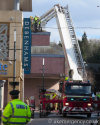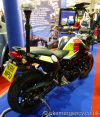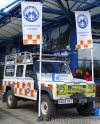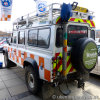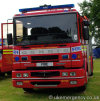Author: ukemergency
G-MCGB A Sikorsky S-92A that is used for search and rescue operations by HM …

G-MCGB A Sikorsky S-92A that is used for search and rescue operations by HM Coastguard.
A look at the back of the craft.
The helicopter takes flight and skims along the ground.
The rescue chopper as seen from below.
The winchman is lowered from the craft over the sea.
Watch a video of this vehicle in action!
G-REDP This is a Eurocopter AS332L2 that is operated by Bond. It is used for rescue …

G-REDP This is a Eurocopter AS332L2 that is operated by Bond. It is used for rescue operations in the North Sea area.
A look at the craft from the side.
The rescue helicopter on a low level test flight, rippled by the heat haze.
The aircraft undergoing routine servicing in its hanger.
Watch a video of this vehicle in action!
TFC 953 A 1953 Morris Minor fire engine. It was built entirely by Morris Motors and was …

TFC 953 A 1953 Morris Minor fire engine. It was built entirely by Morris Motors and was used at their Oxford factory. It was operational from 1953-1983 as a front line appliance and fully retired in 1990.
The rear view. It has a 4 cylinder, 1098cc A-series engine fitted.
The overhead view showing the small dimensions and wooden ladder.
WX53 PVE This Mountain Rescue ambulance carries wording down the sides stating …

WX53 PVE This Mountain Rescue ambulance carries wording down the sides stating ‘working with Avon and Somerset Constabulary’. It carries blue flashing lights but no roof-mounted light bar.
The rear view shows how the car has all bases covered with wording including: police, ambulance, mountain rescue, rescue, cliff rescue and search and rescue.
PO12 HHU This is Surrey FRS’s Incident Command Unit. The front end is a Renault …

PO12 HHU This is Surrey FRS’s Incident Command Unit. The front end is a Renault Master with bespoke bodywork behind.
A close look at the front grille shows that the Renault badge has been swapped for a Plastisol one, the company that did the conversion.
The lengthy vehicle is extended further by a large awning that swaps around one side and the rear of it. The roof has the usual array of lights and communications equipment.
YJ10 HTX A North Yorks Audi A4 Quattro speeds off a dual carriageway with blue lights …

YJ10 HTX A North Yorks Audi A4 Quattro speeds off a dual carriageway with blue lights flashing. Spray from heavy rain is left in its wake.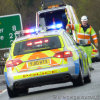
The car now has rear reds flashing and scrolling arrows to direct traffic around a stricken vehicle (not shown). A Highway Agency incident unit has already started to deploy road cones to further help protect the scene.
YJ13 EWU This is one of a pair of prisoner transport vans that were introduced to …

YJ13 EWU This is one of a pair of prisoner transport vans that were introduced to North Yorkshire’s fleet in early 2013. It is an Iveco Daily with a three-litre diesel engine.
The side and rear of the lengthy and tall van.
A look inside from the side sliding door showing the secure individual cells.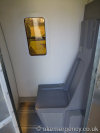
Inside one of the cells is a hard-wearing seat and nothing else. No seatbelts are provided as these could be used to damage the vehicle or the prisoner.
YJ13 EXD A North Yorkshire Vauxhall Astra. It is the 1.3 CDTI Ecoflex model, with the …

YJ13 EXD A North Yorkshire Vauxhall Astra. It is the 1.3 CDTI Ecoflex model, with the frugal engine returning 72 mpg. A fleet of identical vehicles was introduced to the county’s roads in March 2013.
YJ13 EXC The rear view of one of the sister cars. Notice the registration plates are sequential.
YJ13 EWW A further example of the 2013 Astra with a registration plate just a few positions behind the ‘EX_’ range.
The rear view of ‘EWW’.
A side-on view of ‘EWW’.
DDC 1 Carrying Cleveland Fire’s historic cherished number plate DDC1 is their 2012 …

DDC 1 Carrying Cleveland Fire’s historic cherished number plate DDC1 is their 2012 Incident Command Unit.
The rear view of the substantial vehicle. On the side can be seen a TV screen that can show information or TV news channels.
Inside the command unit is like a modern office. Various desks are available as well as a briefing area around a circular table, as seen in the background (at the rear of the vehicle).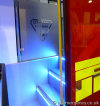
The modern feel extends to the entrance where blue LEDs illuminate the steps and the service’s crest is etched into the glass panels.
EJ05 KXC A 700cc Smart Fortwo in police colours. This is a publicity car used by Onus …
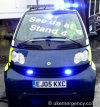
EJ05 KXC A 700cc Smart Fortwo in police colours. This is a publicity car used by Onus Technologies.
The nearside of the Smart car showing the ambulance colours and company logos.
The rear and offside of the car where it has the conflicting colour scheme of a police vehicle! Rear red flashing lights supplement the roof-mounted light bar.
A very early fire appliance dating from 1678. This is not a replica – it is original and well …
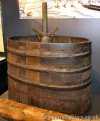
A very early fire appliance dating from 1678. This is not a replica – it is original and well over 300 years old. It was built in London by John Keeling. It originally stood on wheels and the mechanism in the centre had arms on either side (now missing) for four men to pump the water. One further man stood on top and used the hose. The barrel had to be constantly re-filled with buckets of water by further assistants.
A model of the fire appliance showing how it would have looked from new with all of the pieces in place. After the Great Fire of London in 1666, more of this type of fire appliance were ordered and by 1700 their use had become commonplace.
RTW 663 A beautifully preserved Ford Pilot police car. This is a 1950 example of the …

RTW 663 A beautifully preserved Ford Pilot police car. This is a 1950 example of the V8 4-Door car that served with Essex Police. It has the Winkworth bell, siren, spotlight and police plate shown.
A look at the front of the Ford Pilot. There are no blue flashing lights – just illuminating the headlights would attract attention.
The rear view, showing a further police plate.
LD58 DNO A Yamaha FJR that is used as a special blood bike to replenish sticks carried …
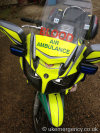
LD58 DNO A Yamaha FJR that is used as a special blood bike to replenish sticks carried by the Kent Air Ambulance. It is the first bike of its type and is an ex-police bike that is now operated by SERV Kent. The bike goes to the air base each night to swap unused blood for fresh.
The side of the bike. The bike is also able to replenish the air ambulance at an emergency scene if required.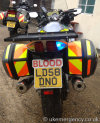
The rear of the FJR. The bike is fitted with blue lights and siren and is registered as an emergency vehicle and the blue lights are used by trained, experienced riders. Note the covert blue lights in the indicator clusters rather than a traditional light pole fitted to the pannier.
A plaque commemorating a previous site of the London Salvage Corps. The text reads …

A plaque commemorating a previous site of the London Salvage Corps. The text reads ‘On this site stood the headquarters of the London Salvage Corps 1907 to 1960’.
A wider look at the location of the plaque. It is above the entrance to a Japanese restaurant on Watling Street in The City area of London. The original building was demolished and replaced with this one.

